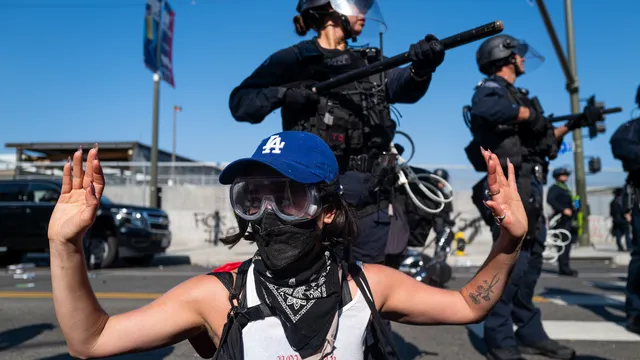
Mexican flags wave as protests erupt against ICE raids in Los Angeles
2025-06-12 12:45- Protests broke out in Los Angeles in response to ICE raids targeting immigrant workers.
- Participants waved the Mexican flag, symbolizing pride and solidarity with the immigrant community.
- The protests highlight ongoing national debates over immigration policies and cultural identity.
Express your sentiment!
Insights
In June 2025, protests erupted in Los Angeles, a city deeply connected to the Mexican diaspora, following a series of raids conducted by the U.S. Immigration and Customs Enforcement (ICE) in the garment district. Demonstrators gathered to express their outrage over the Trump's administration's mass deportation policies. The protests saw many participants waving the Mexican flag, symbolizing cultural pride and solidarity with immigrant communities. Such displays have a long-standing history in Los Angeles, often representing the cultural identity of Latino residents amidst ongoing immigration debates. The protests commenced after ICE's aggressive actions, which many believe targeted undocumented workers and instigated public outcry. The chants of demonstrators were directed not only at the administration's deportation tactics but also aimed at the broader issues of immigrants' rights and systemic racism. Initially peaceful, these gatherings quickly escalated into confrontations, leading to dozens of arrests and reports of violence, which drew attention nationwide and heightened tensions around the immigration issue. Critics of the administration, including scholars and activists, argued that waving the Mexican flag should not be seen as un-American but rather as an expression of cultural pride. National leaders, including President Donald Trump and other prominent Republicans, responded with fierce criticism of the protesters, labeling them as insurrectionists. This rhetoric reflects a long-standing tactic employed by the Trump administration to shift any immigration-related protest into a nationalistic debate, framing those who demonstrate for immigrant rights as threats to American values. Groups opposing the protests emphasized a narrative of American patriotism being undermined, despite many protestors asserting their rights to expression protected under the First Amendment. The ongoing protests not only reflect issues of immigration policy but also expose the societal rifts in the U.S. regarding cultural identity and the rights of immigrants. Historically, Los Angeles has been a focal point for such conflicts, marking its place as a center of Latino culture and immigrant activism in the United States. As the situation in Los Angeles continues to unfold, it serves as a lens to examine broader immigration policies and the perception of cultural symbols in America.
Contexts
The history of immigration protests in Los Angeles is a reflection of the city's diverse demographics and the complex relationship between its residents and immigration policies. Los Angeles, as a major destination for immigrants from around the world, has been the site of significant activism related to immigration issues, particularly since the late 20th century. The rise of protests can be traced back to the 1980s and 1990s, when waves of Latin American immigrants, particularly from Mexico and Central America, began arriving in the city seeking better opportunities. This influx was accompanied by increasing tensions and debates around immigration policy, leading to organized efforts to advocate for immigrant rights and policy reform. The emergence of groups such as the Coalition for Humane Immigrant Rights of Los Angeles (CHIRLA) in the late 1980s marked a pivotal moment in the mobilization of these communities against discriminatory policies and for the recognition of their contributions to society. One of the most significant moments in the history of immigration protests in Los Angeles occurred in 2006, when millions of people took to the streets in what became known as the "Great American Boycott" or "A Day Without Immigrants." This mass mobilization was sparked by proposed legislation that aimed to increase penalties for undocumented immigrants and those who assist them. The protests drew a diverse coalition of participants, including immigrants, labor unions, students, and various civil rights organizations, all united in opposition to what they viewed as unjust policies. The sheer scale of the protests sent a powerful message to lawmakers and brought national attention to the plight of immigrants, illustrating the integral role they play in the economy and community fabric. In subsequent years, immigration protests have continued in response to shifts in national policies and local enforcement practices. Advocacy groups organized rallies and demonstrations against measures perceived as hostile to immigrant communities, such as increased deportations and the establishment of laws that criminalized being undocumented. Notably, the election of President Donald Trump in 2016 ignited a new wave of activism, particularly surrounding the issues of family separation and the travel ban. Los Angeles, with its significant immigrant population, served as a focal point for resistance, with protests often held in front of city hall and other prominent locations. These events were characterized by their multicultural participation, with various community subsets standing in solidarity, demonstrating a deep-rooted commitment to advocating for immigrant rights. As of 2025, the legacy of these protests continues to shape the discourse around immigration in Los Angeles. Ongoing debates on reform and community protections remain vibrant within the socio-political landscape. The protests have not only contributed to raising awareness and influencing public opinion but also have empowered the immigrant community to demand legal reforms and protections. Events such as May Day rallies and youth-led protests highlight the enduring spirit of activism that characterizes Los Angeles as a place of resistance and resilience. The evolution of immigration protests in the city stands as a testament to the challenges faced by immigrant communities while also underscoring their active pursuit of justice and equality within the framework of the American landscape.